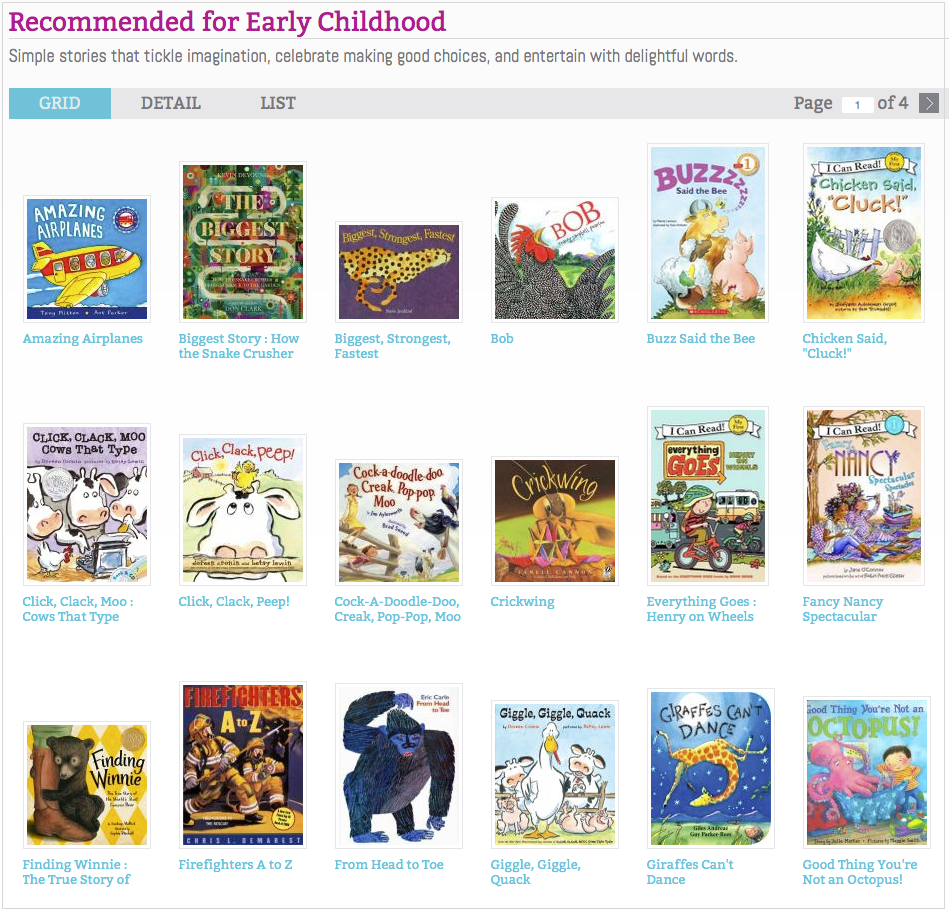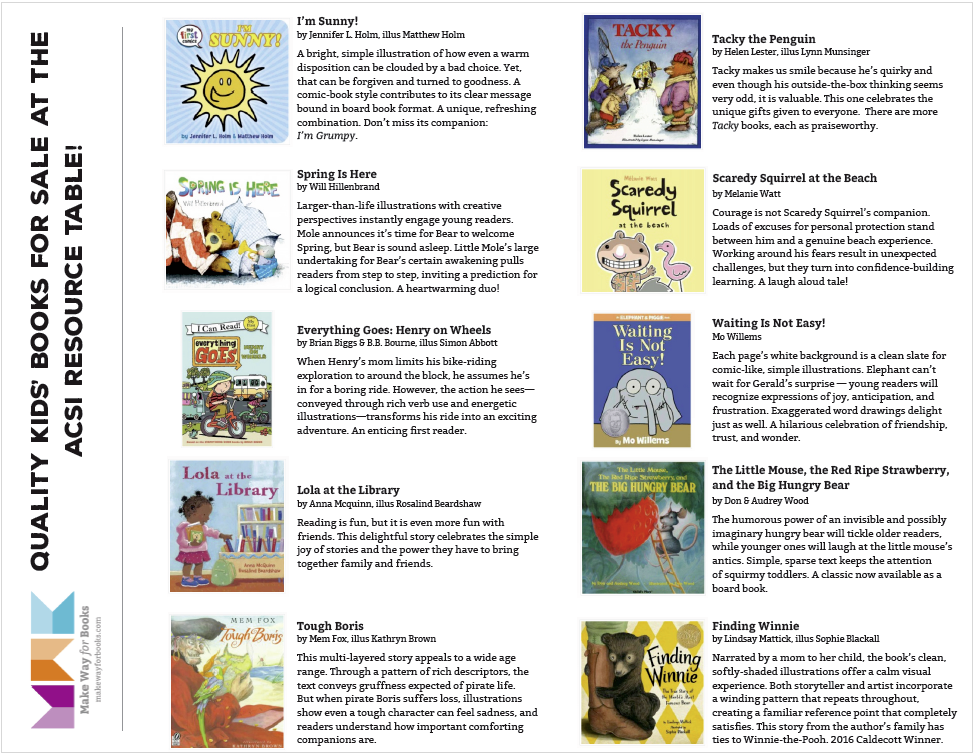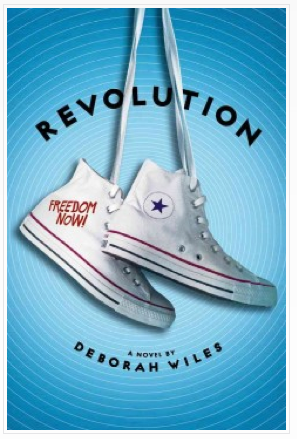Would having 32 kid-friendly parts-of-speech and grammar titles at your fingertips be handy? Look no further! These titles come from collections created by four authors we recommend. Continue reading
All posts by Julia
Spot Light • March 2016

We were asked to provide a quality collection of 25 titles for an Early Childhood conference this month. We sent 25 titles, but were ready with 35 more! Here are all 60 recommended titles.
Here’s a handout we gave to conference attendees. Please share it with your Early Childhood parents and teachers!
Spot Light • February 2016

This month’s 12 (mostly) biographies represent many walks of life and periods of time—most interestingly, some of their paths could have crossed. Their stories challenge us to live a story worth writing about.
(Check out our History’s Stories pages to find these stories and more arranged chronologically.)
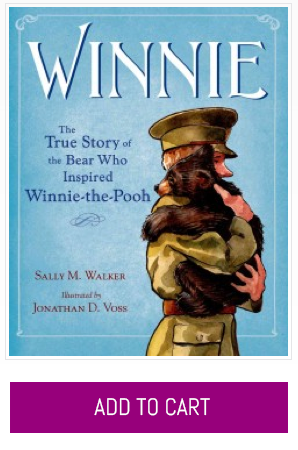 Winnie: The True Story of the Bear Who Inspired Winnie-the-pooh
Winnie: The True Story of the Bear Who Inspired Winnie-the-pooh
by Sally M. Walker, illustrated by Jonathan D. Voss
(Henry Holt & Co., 2015 • Ages 6-7)
$17.99 retail $14.39
Publisher Summary When Harry Colebourn saw a baby bear for sale at the train station, he knew he could care for it. Harry was a veterinarian. But he was also a soldier in training for World War I. Harry named the bear Winnie, short for Winnipeg, his company’s home town, and he brought her along to the training camp in England. Winnie followed Harry everywhere and slept under his cot every night. But who could care for the bear when Harry had to go to the battleground in France? Harry found just the right place for Winnie while he was away—the London Zoo. There a little boy named Christopher Robin came along and played with Winnie—he could care for this bear too! Sally Walker’s heartwarming story, paired with Jonathan Voss’s evocative illustrations, brings to life the story of the real bear who inspired Winnie-the-Pooh.
Make Way for Books Heartwarming watercolor illustrations depict the delight Harry Coleburn, military veterinarian took in his new charge, Winnifred the black bear. While the storyline follows the endearing role Winnie played among soldiers at military camps, it conveys the critical role animal health, especially the horses’, played during World War I. The well-woven story comes full-circle when Winnie’s story collides with Christopher Robin, who renames the stuffed bear in his care Winnie-the-pooh after the gentle bear he met at the London Zoo. Who better to craft beloved tales of the child-animal bond, than his father, A.A. Milne. Masterful storytelling in a biographical genre.
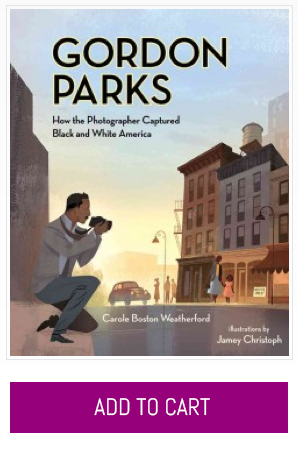 Gordon Parks: How the Photographer Captured Black and White America
Gordon Parks: How the Photographer Captured Black and White America
by Carole Boston Weatherford, illustrated by Jamey Christoph
(Albert Whitman & Co., 2015 • Ages 6-7)
$16.99 retail $13.59
Publisher Summary Gordon Parks is most famous for being the first black director in Hollywood. But before he made movies and wrote books, he was a poor African American looking for work. When he bought a camera, his life changed forever. He taught himself how to take pictures and before long, people noticed.
Make Way for Books A magazine spread about migrant workers moved then-porter Gordon Parks to buy a camera and teach himself the craft. He sensed injustice, particularly “the unfairness of segregation” and soon learned to tell its story through the lens. His skilled shots eventually landed in major magazines, their first captures by a black photographer. An impactful way to show how the efforts of one man can give voice to those without.
 The Pullman Porter: An American Journey
The Pullman Porter: An American Journey
by Vanita Oelschlager, illustrated by Mike Blanc
(Ingram Pub Services, 2014 • Ages 6-7)
$8.95 retail $7.16
Publisher Summary Children and adults under the age of 40 are forgetting about the Pullman Porter. They were very important figures in the history of American. This book will teach children and adults, who the porters were and why they were so important in our history. Porters worked in early train cars, they would look, listen and learn from their predominantly white passengers. They would read the newspapers passengers left behind, listen to conversations and begin to talk to one another. The porter learned how important education was for children and how important it was to take this message home to his children. He eventually landed at the forefront of the civil rights movement.
Make Way for Books Against the backdrop of the Pullman Car invention (1857) and its African American Pullman porters, readers watch as a seed of the Civil Rights movement takes root—when pitiful living conditions, low wages, and long hours devalue lives of recently-freed men—and grows into a demand for justice. History’s sequence falls into place as well-known figures impact the timeline of this movement: President Franklin D. Roosevelt, his wife, First Lady Eleanor Roosevelt, Abraham Lincoln’s son, Robert Todd Lincoln, Rosa Parks, and eventually Martin Luther King, Jr. An important legacy shared with relevance and respect.
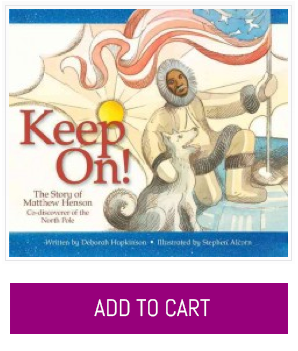 Keep On!: The Story of Matthew Henson, Co-discoverer of the North Pole
Keep On!: The Story of Matthew Henson, Co-discoverer of the North Pole
by Deborah Hopkinson, illustrated by Stephen Alcorn
(Peachtree, 2015 • Ages 7-8)
$7.95 retail $6.36
Publisher Summary Many know the story of Robert Peary’s great 1909 expedition to reach the North Pole. Yet few people know that Peary was joined on this grueling, history-making journey by fellow explorer Matthew Henson. Henson was born just after the Civil War, a time when slavery had been abolished, but few opportunities were available for black people. Even as a child, he exhibited a yearning for adventure, and at the age of only thirteen, he embarked on a five-year voyage sailing the seven seas and learning navigation, history, and mathematics. Henson’s greatest adventure began when he accepted an invitation from Robert Peary to join his expedition to the North Pole. The team endured storms, shifting ice, wind, injuries, accidents, and unimaginable cold. Finally on April 1, Peary, Henson, and four Inuit men began the final 133-mile push to the Pole.
Make Way for Books From a Maryland cabin to the top of the world, Matthew Henson knew how to take advantage of opportunities, prove himself, and become a partner in exploration and accomplishment. An unforgettable look at an adventurer who deserves to be known by readers, young and old.
 Jack’s Path of Courage: The Life of John F. Kennedy
Jack’s Path of Courage: The Life of John F. Kennedy
by Doreen Rappaport, illustrated by Matt Tavares
(Disney Press, 2010 • Age 6-8)
$17.99 retail $14.39
Publisher Summary John F. Kennedy was a popular, charismatic president, beloved by many. But he didn’t always believe he had the strength or courage for that office. As a child he was sickly and also overshadowed by his strong, capable, athletic older brother Joe. After Joe Jr.’s death John had to work hard to live up to his own expectations and to those of his father. He overcame pain and self-doubt to see the country through one of the most difficult crises in its history. Doreen Rappaport once again combines real-life quotes with her own lyrical prose to create a moving portrait of a beloved figure. Matt Tavares’ stunning artwork vividly depicts this unique time in history.
Make Way for Books Follows the formative years of the highly regarded President, including his competitive childhood, remarkable acts of bravery while in the military, and the significant events of his presidency. Will help readers see courage as the overriding theme of JFK’s life.
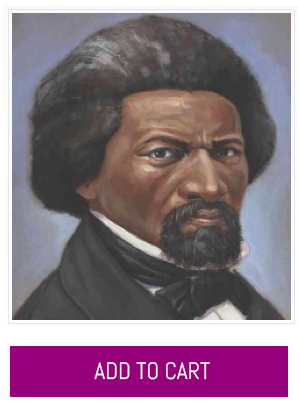 Frederick’s Journey: The Life of Frederick Douglass
Frederick’s Journey: The Life of Frederick Douglass
by Doreen Rappaport, illustrated by London Ladd
(Disney Press, 2015 • Age 7-8)
$17.99 retail $14.39
Publisher Summary Frederick Douglass was born a slave. He was taken from his mother as a baby, and separated from his grandparents when he was six. He suffered hunger and abuse, but miraculously, he learned how to read. Frederick read newspapers left in the street, and secretly collected spellings from neighborhood children. Words, he knew, would set him free. When Frederick was twenty, he escaped to the North, where he spread his abolitionist beliefs through newspaper articles, autobiographies, and speeches. He believed that all people —regardless of color or gender—were entitled to equal rights. It is Douglass’s words, as well as his life, that still provide hope and inspiration across generations.
Make Way for Books Compelling, life-sized, carefully-detailed illustrations, punctuate the depth of Frederick Douglass’s devotion to justice and liberty for all. The dark pain of loss at a young age translated into grim determination to learn words because “…Frederick sensed that words had power. …he traded food for words.” In a world growing more accustomed to byte-sized snippets of communication, Rappaport reminds us to value speaking well, because there is hope in words. A rivoting story that unfolds easily with Douglass’s own phrases scattered throughout, still challenging, still inspiring.
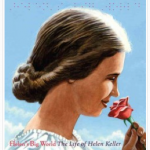 |
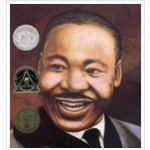 |
See also Helen’s Big World and Martin’s Big Words
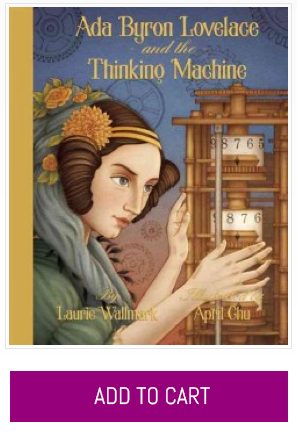 Ada Byron Lovelace and the Thinking Machine
Ada Byron Lovelace and the Thinking Machine
by Laurie Wallmark, illustrated by April Chu
(PGW, 2015 • Ages 8-12)
$17.99 retail $14.39
Publisher Summary Ada Lovelace, the daughter of the famous romantic poet, Lord Byron, develops her creativity through science and math. When she meets Charles Babbage, the inventor of the first mechanical computer, Ada understands the machine better than anyone else and writes the world’s first computer program in order to demonstrate its capabilities.
Make Way for Books This is a richly layered biography, best enjoyed by late elementary ages. Ada Byron Lovelace possessed an inquisitive mind that relished numbers, patterns, and challenge. However, she grew up during a time when measles and cholera puzzled the medical community, and both left her very ill. It was also a time when men were more readily associated with the mathematical work and invention for which Ada obviously possessed natural talent. A closing author’s note and timeline shed additional light on this woman’s significant accomplishments, all of which occurred before her death at the age of 36. A truly inspiring life whose contributions to the computer and its language should be known by today’s tech-savvy kids.
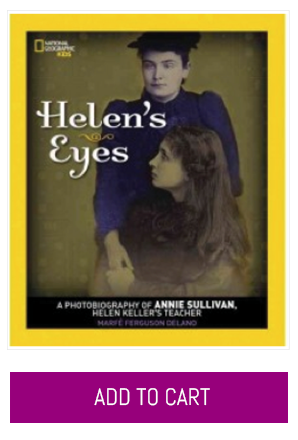 Helen’s Eyes: A Photobiography of Annie Sullivan, Helen Keller’s Teacher
Helen’s Eyes: A Photobiography of Annie Sullivan, Helen Keller’s Teacher
by Marfe Ferguson Delano
(National Geographic Children’s Books, 2015 • Ages 9-11)
$7.99 retail $6.39
Publisher Summary Frederick Douglass was born a slave. He was taken from his mother as a baby, and separated from his grandparents when he was six. He suffered hunger and abuse, but miraculously, he learned how to read. Frederick read newspapers left in the street, and secretly collected spellings from neighborhood children. Words, he knew, would set him free. When Frederick was twenty, he escaped to the North, where he spread his abolitionist beliefs through newspaper articles, autobiographies, and speeches. He believed that all people —regardless of color or gender—were entitled to equal rights. It is Douglass’s words, as well as his life, that still provide hope and inspiration across generations.
Make Way for Books Had Annie Sullivan never been associated with Helen Keller, her life would still have been remarkable. This account follows Sullivan from a childhood of poverty and hardship through her amazing accomplishments with her better-known student. This is a powerful retelling of an amazing and accomplished life!
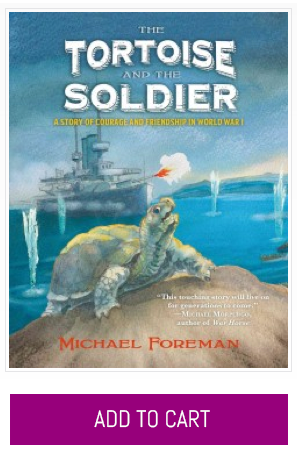 The Tortoise and the Soldier: A Story of Courage and Friendship in World War I
The Tortoise and the Soldier: A Story of Courage and Friendship in World War I
by Michael Foreman
(Henry Holt & Co., 2015 • Ages 9-11)
$13.59 retail $16.99
Paperback edition coming November 2016
Publisher Summary As a boy, Henry Friston dreamed of traveling the world. He thought he was signing up for a lifetime of adventure when he joined the Royal Navy. But when World War I begins, it launches the world, and Henry, into turmoil. While facing enemy fire at Gallipoli, Henry discovers the strength he needs to survive in an unexpected source: a tortoise. And so begins the friendship of a lifetime. Based on true events, and with charming illustrations, this story of war, courage, and friendship will win the hearts of readers.
Make Way for Books A biographical account of Henry Friston that flows with ease. While it chronicles this noble character and how his dreams for world travel eventually merge with military service, the story’s compelling appeal stems from the way Michael Foreman chose to tell it — through the eyes of an aspiring reporter who sought the truth, persisted over time, experienced intergenerational friendship, and grew from its wisdom.
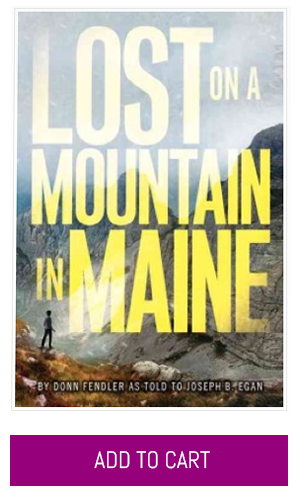 Lost on a Mountain in Maine
Lost on a Mountain in Maine
by Donn Fendler, edited by Joseph B. Egan
(Harper Collins, 1992 • Ages 9-11)
$5.99 retail $4.79
Publisher Summary Based on the true account of a boy’s harrowing journey through the vast wilderness of the Katahdin Mountains, Lost on a Mountain in Maine is a gripping survival story for all ages. With rainstorms, black bears, and his fear of being lost forever, Donn’s journey is a physically, mentally, and emotionally charged story told from the point of view of the boy who lived it.
Make Way for Books [This one’s an autobiography, not to be missed.] While impatience may have led to his predicament, Donn’s patience and tenacity enabled his survival for nearly two weeks. Throughout the ordeal, he never gave up hope, believing Someone was watching over him. A truly inspiring story of faith, hope, and struggle set in a wilderness rarely traveled by humans.
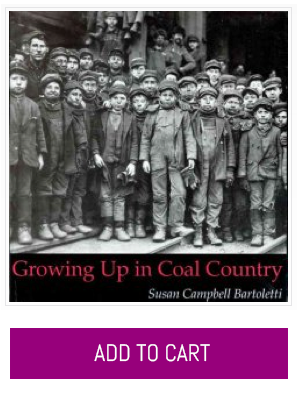 Growing Up in Coal Country
Growing Up in Coal Country
by Susan Campbell Bartoletti
(Houghton Mifflin, 1999 • Ages 9-11)
$9.99 retail $7.19
Publisher Summary Based on personal interviews, newspaper accounts, mining inspection records, and other original sources, a portrait of life in the Pennsylvania coal mines and “patch villages” tells the heartbreaking but life-affirming story of children and adults for whom this region represented a way of life.
Make Way for Books [Though not a biography, it is nonfiction that reads like a generalized biography] This stunning collection of photos and commentary chronicling the coal industry of Northeast Pennsylvania in the late 1800’s and early 1900’s evokes compassion for those families dependent upon mining jobs for survival. From interviews of former miners, Susan Bartoletti shows the plucky spirit of the youngest workers (often under 10 years old), the tragic consequences of a slip-up, the desperate living quarters of the large families, and eventually the organized strikes that led to union formations. An informative and thought-provoking work at a challenging reading level.
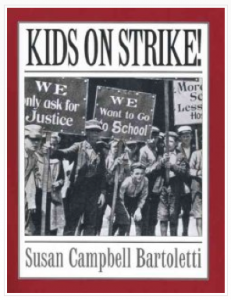
See also Kids on Strike
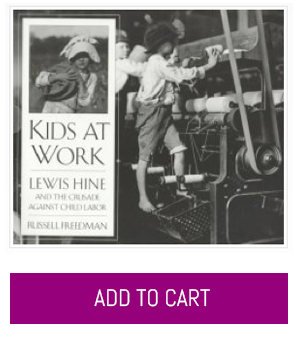 Kids At Work
Kids At Work
by Russell Freedman, photographs by Lewis Hine
(Houghton Mifflin, 1998 • Ages 12-14)
$9.95 retail $7.96
Publisher Summary Photobiography of early twentieth-century photographer and schoolteacher Lewis Hine, using his own work as illustrations. Hines’s photographs of children at work were so devastating that they convinced the American people that Congress must pass child labor laws.
Make Way for Books In his trademark photobiographical style, Freedman chronicles the life and accomplishments of Lewis Hine, schoolteacher turned activist and his fight against child labor in the early 1900’s. Haunting photographs taken by Hine highlight the well-developed text, breathing life into this man’s story
Spot Light • February 2015
This month we highlight 12 nonfiction titles for a variety of ages. Some are novel in their approach to conveying information, while others inspire by exquisite writing, sound reasoning, or well-balanced visual design and historical retelling.
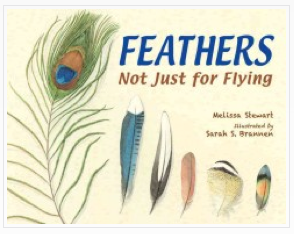 Feathers: Not Just for Flying
Feathers: Not Just for Flying
by Melissa Stewart, illustrated by Sarah S. Brannen
(Random House, 2014)
Publisher Summary Young naturalists meet sixteen birds in this elegant introduction to the many uses of feathers. A concise main text highlights how feathers are not just for flying. More curious readers are invited to explore informative sidebars, which underscore specific ways each bird uses its feathers for a variety of practical purposes. A scrapbook design showcases life-size feather illustrations.
Make Way for Books This is nonfiction at its finest. With such lifelike illustrations, there is little doubt readers would recognize these feathers on a nature walk. Brief, handwritten descriptions of each feathered creature convey the feel of a field journal, personalizing the reading experience and adding depth to each simile that describes a feather’s purpose. It took a few years and many drafts before Melissa Stewart “latched onto the idea to compare feathers to common objects in our lives.” The result is a tightly knit summary spread by spread that is gentle, informative, and somehow a little more extraordinary.
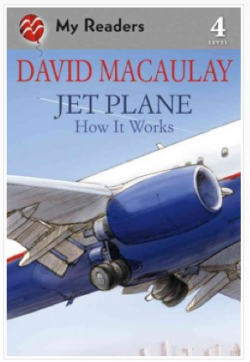 Jet Plane: How It Works
Jet Plane: How It Works
by David Macaulay
(Henry Holt, 2012 – new edition coming April 2015)
Publisher Summary Go on an airplane ride. It weighs as much as 100 elephants, but it can fly for hours. How does a jet do that? From the engine that provides the power and wings that lift the plane off the ground to the cockpit controls and passenger cabin, see how these modern marvels work and what makes them stay in the air. The Caldecott Medal-winning creator of The Way Things Work presents a fact-filled, visual profile of the jet plane that details its modern workings and scientific principles.
Make Way for Books Macaulay invites readers to enjoy a flight, then shows and describes the plane’s behavior on takeoff, during flight, and landing. His masterful drawings include just enough detail to clearly illustrate difficult concepts. He adds visual metaphor to strengthen his points, and uses angles and cross sections to reveal unique plane parts and systems associated with an everyday flight. Macaulay makes learning fun and fascinating.
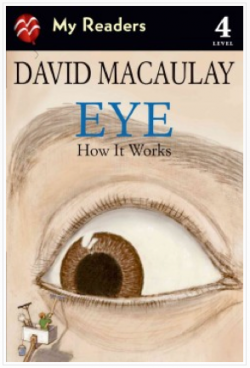 Eye: How It Works
Eye: How It Works
by David Macaulay
(Henry Holt, 2012 – new edition coming April 2015)
Publisher Summary How can you see that your shirt is on inside out? How do you see the soccer ball coming right at you? How do you know which players are on your team? It all starts with light, and with the amazing human eye. With his unique blend of informative text and illustration, David Macaulay shows how the anatomy of this extraordinary organ works to capture light and send signals to our brains.
Make Way for Books Macaulay’s clever way of showing the eye and its parts and telling its purpose by including it as an active “player” in the story’s unfolding soccer match, provides a rich, multi-sensory reading experience. By the story’s end, readers can more fully appreciate this organ’s importance and its multi-layered protective construction. An effective primer.
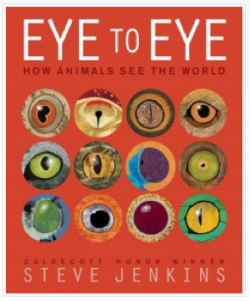 Eye to Eye: How Animals See the World
Eye to Eye: How Animals See the World
by Steve Jenkins
(Houghton Mifflin Harcourt, 2014)
Publisher Summary In his latest eye-popping work of picture book nonfiction, the Caldecott Honor–winning author-illustrator Steve Jenkins explains how for most animals, eyes are the most important source of information about the world in a biological sense. The Caldecott Honor-winning creator of What Do You Do with a Tail Like This? artistically profiles a series of animals with unusual eyes, explaining how such animals use their [unique] eyes to gain essential information about the biological world.
Make Way for Books Steve Jenkins is a master of details and perspective in a world of cut-paper illustration. While his art mesmerizes, page after page, satiating the most curious observer, the same attention is given to brief explanations that inform often by using comparisons. There is mention of eyes evolving over millions and billions of years, yet the focus is squarely on the stunning eyes of these lesser-known creatures—their uses and characteristics. A breathtaking celebration of unique creations.
Pair this with David Macaulay’s Eye: How It Works for a fascinating comparison/contrast study.
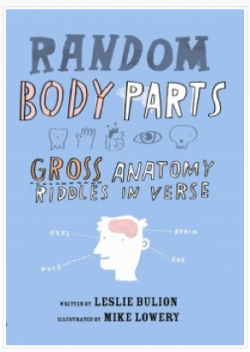 Random Body Parts: Gross Anatomy Riddles in Verse
Random Body Parts: Gross Anatomy Riddles in Verse
by Leslie Bulion, illustrated by Mike Lowery
(Peachtree, 2015 – available early March)
Publisher Summary Witty and nimble verse about body parts pairs with whimsical drawings in this informative, fun-filled collection. It begins with an invitation to solve a series of poetic riddles. Each poem that follows poses a puzzle in verse (with a sly wink and a nod to Shakespeare) and provides hints for uncovering the body part in question. Sidebars further educate readers about the anatomical subject in question, while appended notes offer a crash course on poetic form and a few facts about the Shakespearean works that inspired the verses. A glossary for science terms is included in the back matter.
Make Way for Books This book was a brave undertaking; it is an anatomy reference guide illustrated by layers of photographs and child-like drawings, and explained by concise conversational-styled encyclopedic entries that are retold in poetic formats—in the style of Shakespeare’s works. Although an initial read could construe it as too ambitious, the cleverness makes it the perfect book for writing instruction (and science too). There is a plethora of figurative language used to describe the design and use of various body parts. Engage readers in creating a similar description activity to appreciate the challenge this author-illustrator team tackled. Both entertaining and educational.
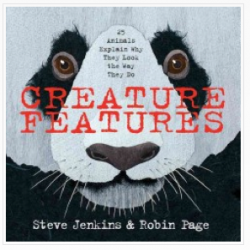 Creature Features: 25 Animals Explain Why They Look the Way They Do
Creature Features: 25 Animals Explain Why They Look the Way They Do
by Steve Jenkins and Robin Page
(Houghton Mifflin Harcourt, 2014)
Publisher Summary The Caldecott Honor-winning duo get face-to-face with unique animals from around the world in this playful exploration of unusual animal facial features.
Dear axolotl: Why do you have feathers growing out of your head? Axolotl: They aren’t feathers—they’re gills! They let me breathe underwater.
Packed with many cool facts and visuals on where certain animals live and what they eat, this book captures twenty-five humorous—and very true—explanations of why animals look the way they do in order to exist in this world.
Make Way for Books With creature names like “star-nosed mole,” “harpy eagle,” and “shoebill stork,” intrigue begins at page one. This talented author/illustrator duo introduces one animal at a time, close-up, asking one question that every reader would ask based on colorful, textured, paper-cut illustrations that cleverly-highlight a peculiar feature. Conversational, one to three-sentence answers satisfy curiosity and are supplemented by a well-rendered graphic on the closing pages. Silhouettes of every animal—proportionately-sized side-by-side—along with keyhole-sized maps displaying habitats help readers grasp large-scale context. Masterful nonfiction.
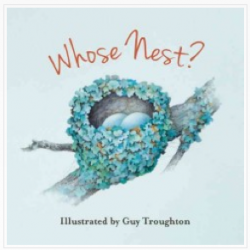 Whose Nest?
Whose Nest?
by Victoria Cochrane, illustrated by Guy Troughton
(PGW, 2013)
Publisher Summary Can you guess whose nest? Take a peek into the nest and look at the clues that surround it—a feather, a footprint, a tasty food morsel—and guess whose nest. Then turn the page to find out who really lives there. The animals include: dormouse, tree frog, clownfish, eagle, rabbit, mallard duckling, bumblebee, and gecko.
Make Way for Books Rich watercolor illustrations entice young book lovers to this interactive, lift-the-flap book. There is no gimmick here; each spread presents a simple riddle that describes an animal’s home. Rich vocabulary—I weave my secret nest…honeysuckle tree…oval hideaway…I nibble sweet berries and gnaw on hazelnuts—delights and inspires inquiry. The text requires a young nature lover to connect his experience with contextual clues in order to predict the creature’s identity. Lifting the flap to reveal the answer is a simple reward, yet completely engaging.
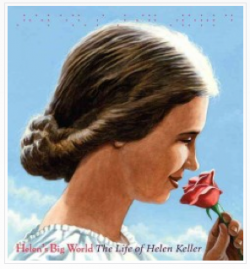 Helen’s Big World: The Life of Helen Keller
Helen’s Big World: The Life of Helen Keller
by Doreen Rappaport, illustrated by Matt Tavares
(Disney, 2012)
Publisher Summary This picture book biography is an excellent and accessible introduction for young readers to learn about one of the world’s most influential luminaries. With her signature style of prose laced with stirring quotes, Doreen Rappaport brings to life Helen Keller’s poignant narrative. Acclaimed illustrator Matt Tavares beautifully captures the dynamism and verve of Helen Keller’s life and legacy, making Helen’s Big World an unforgettable portrait of a woman whose vision for innovation and progress changed America, and the world, forever.
Make Way for Books Large watercolor illustrations warmly portray Helen Keller—overcomer, speaker, and briefly, actress. This reading experience highlights Annie Sullivan’s belief in Helen’s potential, and Helen’s increasing connections that strengthened her mind and ambition. Readers sense the importance of pushing beyond difficult limits. Large-print quotes give voice to Helen’s dogged determination that highlight the expansive world she chose to influence.
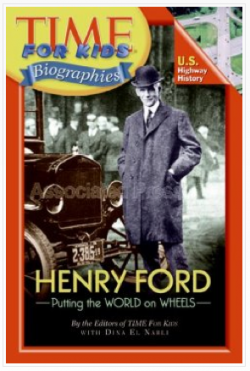 Henry Ford: Putting the World on Wheels
Henry Ford: Putting the World on Wheels
by Time for Kids Magazine Editors with Dina El Nabli
(HarperCollins, 2008)
Publisher Summary As a young boy, Henry Ford was fascinated by technology and how objects worked. His childhood interests led him to leave the Ford family farm in Michigan in search of a career with machinery, and the rest is automotive and economic history…Henry Ford made cars affordable, turning them into the primary means of travel for Americans. His innovations, including the assembly line, are still benefiting us today.
Make Way for Books This early-reader biography is well-designed with text, photos, posters, and ads establishing the essence of Henry Ford’s era. Sidebars with incidental trivia highlight interesting connections, including his friendship with Thomas Edison. The story is realistic and feels timeless because of the character traits used to shape its telling—hard work, inquiry, persistence, experience, and vision—transcend eras. This inspires big thinking.
Did you know Helen Keller and Henry Ford were contemporaries? Check out History’s Stories, our literary timeline to see what other important figures may have crossed their paths.
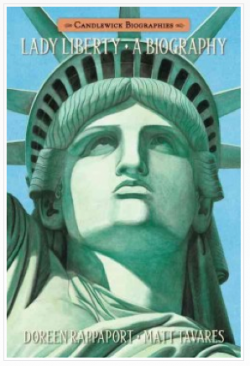 Lady Liberty: A Biography
Lady Liberty: A Biography
by Doreen Rappaport, illustrated by Matt Tavares
(Candlewick, 2014)
Publisher Summary A powerfully moving, authentic portrait of the Statue of Liberty, told through the eyes of those who created her and illustrated in glorious detail.
Soon America will be one hundred years old. I share my dream of a birthday gift.
It begins in 1865 as a romantic idea, but ten years later Édouard Laboulaye’s dream catches fire and takes shape. Sculptor Auguste Bartholdi gives the dream the form of a lady, holding a torch to “enlighten the world.” Engineers, plasterers, carpenters, coppersmiths—many of them immigrants—work together to turn the lady into a monument over 100 feet tall. Joseph Pulitzer calls on readers to help fund a pedestal, and hundreds send in nickels, dimes, and even roosters for the cause. Doreen Rappaport’s historically accurate, poetic vignettes and Matt Tavares’s magnificent images remind us of the true origins of a national symbol—and show that it took a lot of people to make the Lady.
Make Way for Books Much more than the statue’s history, this series of vignettes told in free verse reveal perspectives, personalities, and events leading up to the dedication of Lady Liberty. The quality of writing and illustration surpass many other books that address the story of the statue.
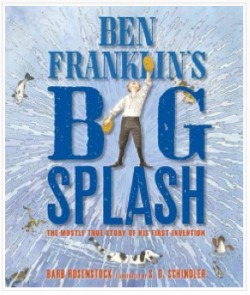 Ben Franklin’s Big Splash: The Mostly True Story of His First Invention
Ben Franklin’s Big Splash: The Mostly True Story of His First Invention
by Barb Rosenstock, illustrated by S.D. Schindler
(Perseus, 2014)
Publisher Summary Every inventor has to start somewhere, and one of the greatest innovators in our history was no exception. Ben Franklin developed his first invention while doing what he loved best: swimming! Ben Franklins’s Big Splash is the story of Franklin’s first invention, his journey through the scientific method, and the surprising successes that results when you’re willing to make mistakes. Barb Rosenstock’s rhythmic, whimsical style is the perfect complement to S. D. Schindler’s pen and ink and watercolor illustrations. Together they recreate history in an engaging and unique way. Both author and illustrator worked closely with Franklin experts; the book includes Franklin quotes, an extensive author’s note, timeline, and bibliography.
Make Way for Books A remarkable read, this story showcases a young Ben Franklin with the curiosity and confidence that would make him a famous inventor. Engaging from the very beginning, this story allows young readers to connect with Benjamin Franklin in new ways and invites them to look into the choices that allowed him to confidently enjoy inventing, even when his inventions failed. Featuring an afterward full of illustrated facts, a timeline, and excerpts from Franklin’s own journal, this is a biography that entertains and instructs.
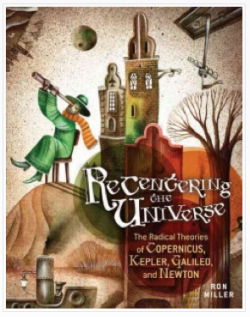 Recentering the Universe: The Radical Theories of Copernicus, Kepler, Galileo, and Newton
Recentering the Universe: The Radical Theories of Copernicus, Kepler, Galileo, and Newton
by Ron Miller
(Lerner, 2013)
Publisher Summary This title shows how a group of European scientists, in the span of roughly 150 years (early 1500s to the mid-1600s) worked through direct observation, overturning the centuries’ old accepted view of a geocentric universe. Through their research and writings, they proposed and described a new order of things in which the Earth orbits the Sun. In so doing, these scientists–Nicolaus Copernicus, Johannes Kepler, Tycho Brahe, Galileo Galilei, and Isaac Newton–challenged the accepted wisdom of the ages, specifically that of the Catholic Church. Galileo was accordingly tried and condemned to house arrest in 1633; the works of many others were banned. Not until the late 1900s did the Church revisit the Galileo case, ultimately concluding that it had made a mistake in suggesting that humans must accept biblical cosmology in literal terms.
Make Way for Books A factual, fair, and fascinating exploration of the scientific shift from and earth-centered models to sun-centered models of the universe. Well-written for middle-grade readers.
Spot Light • January 2015
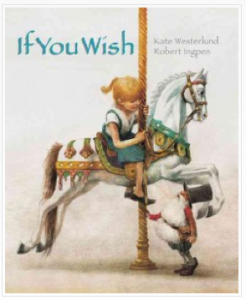 If You Wish
If You Wish
by Kate Westerlund, illustrated by Robert Ingpen
(Independent Pub Group, 2014)
Publisher Summary A strange man and a flying horse teach Willow that when she re-reads a book her imagination can show her brand new stories…This marvelous fantasy, illustrated by the internationally acclaimed Robert Ingpen, will have children re-reading their favorite stories and daring to travel inside the pictures as they discover that books are for more than just reading.
Make Way for Books “You can read a book more than once, you know. You might even find a book inside the book…When you read a book again and let your imagination take over, it can take you to new stories, so it’s like a book inside the book!”
Thus begins a celebration of the power of imagination. This book unfolds as a dream might unfold for a child picturing a scene from a story and then imagining, “what if?” It leads to beautiful places, offers unusual perspectives of usual things, and challenges ordinary thinking to become extraordinary. Rich, dreamlike illustrations capture the glorious adventure this girl discovers by daring to think beyond the pages of her books. For every reader who needs inspiration.
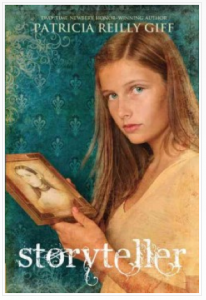 Storyteller
Storyteller
by Patricia Reilly Giff (Random House, 2011)
Publisher Summary Elizabeth is drawn into a dramatic story from the American Revolution when she discovers a portrait of her ancestor, a girl called Zee, who has a striking resemblance to Elizabeth. The girls’ lives intertwine and Elizabeth’s present-day story alternates with Zee’s. As Elizabeth learns about Zee, and walks where Zee once walked and battles raged, the past becomes as vivid and real as the present.
Make Way for Books Patricia Reilly Giff creates a gentle and beautiful story of finding one’s way and place in the world. Two stories, one set during the early days of the America Revolution and the other set in the present, interweave and leave the reader aware and appreciative of the gifts of individuality each person possesses. A well-crafted, affecting reading experience!
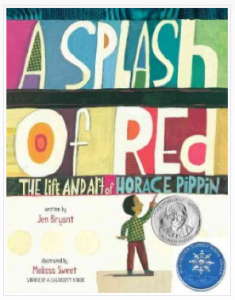 Splash of Red: The Life and Art of Horace Pippin
Splash of Red: The Life and Art of Horace Pippin
by Jen Bryant, illustrated by Melissa Sweet (Random House, 2013)
Publisher Summary As a child in the late 1800s, Horace Pippin loved to draw: He loved the feel of the charcoal as it slid across the floor. He loved looking at something in the room and making it come alive again in front of him. He drew pictures for his sisters, his classmates, his co-workers. Even during World War I, Horace filled his notebooks with drawings from the trenches . . . until he was shot. Upon his return home, Horace couldn’t lift his right arm, and couldn’t make any art. Slowly, with lots of practice, he regained use of his arm, until once again, he was able to paint–and paint, and paint! Soon, people—including the famous painter N. C. Wyeth—started noticing Horace’s art, and before long, his paintings were displayed in galleries and museums across the country. Jen Bryant and Melissa Sweet team up once again to share this inspiring biography of a self-taught painter from humble beginnings who despite many obstacles, was ultimately able to do what he loved, and be recognized for who he was: an artist.
Make Way for Books In an unusual move within book publishing, this author/illustrator team researched Horace Pippin together. The result is a remarkably tight text-illustration experience. While Bryant’s careful word choice flows easily, delighting and informing simultaneously, Sweet’s illustration conveys Pippin’s life story via his folk-art style, as if we readers are privy to his sketching pad. Sweet prominently hand-writes Pippin’s sayings, and illustrates close-up all that is important for Pippin to create his art, deepening the reader experience. This is an inspiring story of a talented individual who bore his responsibility to family and country well, and eventually, to his artistic gift.
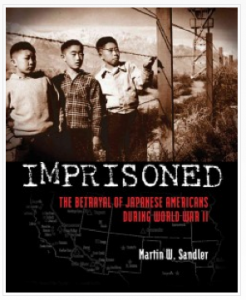 Imprisoned: The Betrayal of Japanese Americans During World War II
Imprisoned: The Betrayal of Japanese Americans During World War II
by Martin W. Sandler (Walker & Co., 2013)
Publisher Summary While Americans fought for freedom and democracy abroad, fear and suspicion towards Japanese Americans swept the country after Japan’s sneak attack on Pearl Harbor. Culling information from extensive, previously unpublished interviews and oral histories with Japanese American survivors of internment camps, Martin W. Sandler gives an in-depth account of their lives before, during their imprisonment, and after their release. Bringing readers inside life in the internment camps and explaining how a country that is built on the ideals of freedom for all could have such a dark mark on its history, this in-depth look at a troubling period of American history sheds light on the prejudices in today’s world and provides the historical context we need to prevent similar abuses of power.
Make Way for Books Sandler presents a remarkable account of the events leading up to, during, and following the internment of Japanese Americans. Punctuated with photographs, the exemplary nonfiction writing provides much more than a history lesson; it delivers a moving and memorable reading experience.
3 Resolutions, Thanks to Squirrel
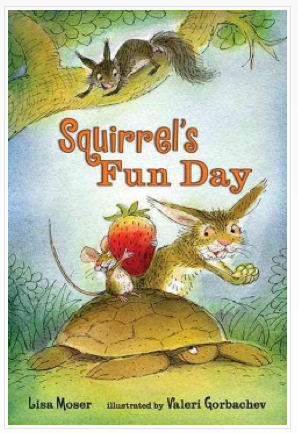 I’ve learned to avoid New Year’s resolutions; however, I may have to break that trend this new year, thanks to Squirrel’s Fun Day by author/illustrator duo Lisa Moser and Valeri Gorbachev.
I’ve learned to avoid New Year’s resolutions; however, I may have to break that trend this new year, thanks to Squirrel’s Fun Day by author/illustrator duo Lisa Moser and Valeri Gorbachev.
The big, wonderfully enchanting world fills squirrel with such enthusiastic delight he determines his only to-do for the day is to have fun. But when he asks Mouse to join him, Mouse replies,
I can’t have fun. I have too much work to do.
I grimace a little because I identify with this scurrying creature. Undaunted, Squirrel pitches in and “helps,” coaxing Mouse to an energetic meadow frolic that somehow finds Squirrel in rescue mode and Mouse covered in strawberry juice.
Although Mouse is finished having fun for the day, Squirrel is filled to bursting with the day’s potential and goes looking for turtle to join him. “Let’s go have fun,” says Squirrel. Turtle replies,
Do I have to get off my log?
I have to remind myself this is a children’s book.
When Squirrel “helps” Turtle with a tricky pond crossing that somehow leads to a mud-coated shell, Turtle is ready for a nap, not more fun.
But once again, Squirrel, so full of energy and ready for more, scampers off to find another buddy to share his fun. To Squirrel’s invitation, rabbit replies,
Oh, no. I can’t have fun. It is time for me to eat grass at the big oak tree…I always do things the same way.
The calendar’s page has just turned: new year. This may be the perfect time to challenge old ways, ruts, and routines. Need-to’s and excuses call for careful scrutiny.
Squirrel’s wisdom winds through my wandering resolve:
Think backwards and see what you didn’t the first time.
Try bridge-building, and meet in the middle.
Fun is everywhere, although its path may be muddy.
And, as it turns out (spoiler alert), Squirrel’s friends were not worse but better for the day’s exuberance:
I stopped working and ate sweet strawberries.
I got off my log and played in the mud.
I don’t need need a trail anymore. I know the way.
Children’s books have a way of reframing the wonder necessary for us to manage in this ever-changing world. And, Professor of Psychology and Behavioral Neuroscience at McGill University, author of The Organized Mind (2014), Daniel J. Levitin, PhD, affirms Squirrel’s advice is just what we need:
We need to be proactive about reducing stress by doing things that reset our working brains—
experiencing nature and art,
allowing the mind-wandering mode to kick in regularly,
and spending time with friends. (p112)
I am resolved. How about you?
Spot Light • December 2014
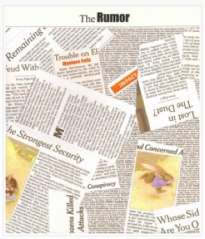 The Rumor
The Rumor
by Monique Felix (Chronicle, 2011)
Publisher Summary Word travels quickly through a peaceful village when a hungry beast is spotted in the hills. Some say he has ears that can hear a potential meal from a mile away! Others declare that his stink is enough to kill you with just one whiff! Still others report that his snout is stronger than a vacuum cleaner! The threat compels friends to warn one another and in humorous fashion turn hearsay into an increasingly inaccurate rumor. Uncertainty abounds, but by the time the villagers are safely gathered together out of harm’s reach, one thing is for sure readers young and old will be charmed by The Rumor!
Make Way for Books When a well-intended, simple warning adopts dramatic changes with each retelling, even youngest readers can predict the dangerous, even ironic impact a rumor may have. A clever tale that uses humor and cause and effect to convey an important concept.
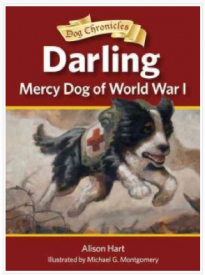 Darling: Mercy Dog of World War I
Darling: Mercy Dog of World War I
by Alison Hart, illustrated by Michael G. Montgomery (Peachtree, 2013)
Publisher Summary This action-packed and heartwarming story of a dog in World War I is the first book in the exciting new Dog Chronicles Series. At home in England, Darling is a mischievous but much-loved pet to Robert and Katherine. But when the British military asks families to volunteer their dogs to help the war effort, they send Darling off to be trained, even though it is very hard to say goodbye. Darling is ultimately used as a mercy dog, seeking out injured soldiers on the battlefield and leading the medics to them. After saving the lives of numerous soldiers, Darling is faced with a major challenge.
Make Way for Books Uniquely told from a dog’s point of view, this book is both authentic and inspiring. While readers witness Darling’s transformation, from spoiled, carefree pet into self-sacrificing war hero, her journey provides a new perspective on World War I and allows readers to think about the kind of character necessary for thinking of others first in moments of life and death. Written with engaging characters and just the right amount of action, this story shows the change that love and loyalty can bring to one’s character. The story’s conclusion includes the history behind the story, along with an extensive bibliography of print and digital resources. (There are some very descriptive battle scenes, and while they are not inappropriate, the death depicted may warrant some discussion prior to reading.)
 Also Available:
Also Available:
Murphy: Gold Rush Dog (Peachtree, 2014)
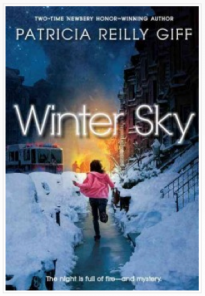 Winter Sky
Winter Sky
by Patricia Reilly Giff (Random House, 2014)
Publisher Summary Sirens! A scary sound, especially to Siria, whose brave pop is a firefighter. Siria loves everyone at Pop’s city firehouse. She also loves to study the stars. Her mother named her after the brightest start in the winter sky.When Siria hears sirens, she sneaks out to chase the trucks, to bring Pop and the other firefighters luck. She’d be in big trouble if she ever got caught. Good thing her best friend, Douglas, is always by her side.As Christmas approaches, Siria suspects that someone in the neighborhood is setting fires. She has to find out who’s doing it. When clues point to a surprising suspect, she realizes that solving this mystery will take all kinds of courage. Patricia Reilly Giff, the author of many beloved and award-winning books, is at her best in this action-packed story.
Make Way for Books “The rescue is everything,” explains Siria’s firefighting father. While watching her courageous father chase sirens through city nights, Siria worries she will lose him, her only parent. Enter a stray dog, suspicions about a close friend who may be an arsonist, and the caring love of several adults, and Siria soon learns despite danger, courage can lead to extraordinary outcomes. As Christmas and her New Year’s birthday approaches, Siria must bravely face her own mistakes and relax in the love that surrounds her. With her usual focus on developing memorable characters, Giff once again provides a story that is poignant and believable.
(paperback available January 2015)
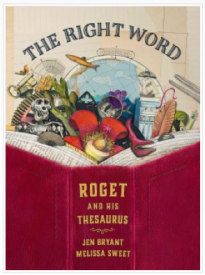 The Right Word
The Right Word
by Jen Bryant, illustrated by Melissa Sweet (Eerdmans, 2014)
Publisher Summary For shy young Peter Mark Roget, books were the best companions—and it wasnt long before Peter began writing his own book. But he didn’t write stories; he wrote lists. Peter took his love for words and turned it to organizing ideas and finding exactly the right word to express just what he thought. His lists grew and grew, eventually turning into one of the most important reference books of all time.
Readers of all ages will marvel at Roget’s life, depicted through lyrical text and brilliantly detailed illustrations. This elegant book celebrates the joy of learning and the power of words.
Make Way for Books “The use of language…[functions] as an instrument of thought; not being merely its vehicle, but giving it wings for flight.” – Peter Mark Roget
Roget’s delight with language oozes from these pages. Illustrations, mostly hand-drawn give the sense Roget is telling his own story—how curiosity and wonder drove his search to capture a moment or thought or concept with just the right word. His vast experience as doctor, inventor, and author both entertains and inspires, showing readers the noble value of inquiry paired with humility. A masterful presentation and a must for lovers of language!
Mending Broken Windows
“…our children shouldn’t have to be afraid. I shouldn’t have to be afraid when they walk out the door.” 1
Last week, my 5 a.m. consciousness struggled to place these newscaster’s words. Somehow, Deborah Wiles’ Revolution, fresh in my mind, projected like a newsreel right into the morning’s story. This news was Ferguson, MO, not Wiles’ Greenwood, MS account. Sadly, I had the same feeling several weeks before.
I had been begun Revolution, a documentary novel of Freedom Summer, 1964.
“The air in Fairchild’s, which always smells like bacon and lettuces and yeasty bread and sawdust and air-conditioning in the summer, was laced with the smell of uncertainty then, and there was a hush from some of the white customers—you could feel it. It was a bristly feeling.” (p. 226)
Wiles has a way of making her readers feel it by placing us in the footsteps of young people. We readers see through their eyes, like fragile windows—smudged, cracked, broken, and mended.
“I asked Daddy the question I most wanted to know the answer to: “What’s going to happen?”
“We’re going to watch, Sunny,” he answered me, “and stick together. Everything will be all right.” (p. 206)
That was when a news report from this summer, July 2014, started up like a movie in my mind. A correspondent was sharing stories of two families sheltering during the escalating conflict in the Gaza Strip.2
In Ashkelon, Israel, 30-40 neighborhood family members hunkered in an underground concrete bunker.
“My kids are very anxious,” [one mother says]. They won’t go home to sleep, or shower, or eat…they’re terrified.” “Things are not OK,” [her 10-year-old son says]. “I’m scared.”
The correspondent asks the boy if he ever thinks that kids in Gaza might feel the same. “My mother told me there were sirens there, too,…and those kids also have to run away.”
In Gaza City, families have no bunker to defend against bombing.
“Sometimes I lie,” [says one father]. “I tell my kids, ‘Those aren’t bombs; they’re fireworks.’ When it’s huge, I try to act carefree so they’ll see me and feel reassured.”
“We feel so scared, ” says one 10-year old. The report continues, “she is angry that Israelis can hide in shelters, while her family and people are killed.” When the correspondent asks the girl if she wants Israeli kids to die too, she responds, “They are like me. They have rights. They shouldn’t die. They should be protected, just like we should be protected.”
In an interview with teachingbooks.net, Wiles was asked why she chose to write about Freedom Summer:
I wanted to show the larger arc of our nation’s history, juxtaposed against an individual’s smaller arc. History is made by individuals, one moment at a time. By experiencing Sunny’s walk through it [in Revolution]…, readers see that, choice by choice, they craft a life.3
Wiles has crafted a masterpiece. The angst of youth amidst a rapidly changing, chaotic period colors it. Although poignant photographs document the time — the Beatles, soldiers in South Vietnam, Willie Mays, Freedom Houses — in black and white, this tale’s young heroes, both black and white, see in all shades of gray as they search for understanding and meaning-making. Notably, each chapter’s beginning page is vertically edged with a scale of grays ranging from black to white extremes, reminiscent of a test print pattern. Though subtle, readers see what uncertainty looks like.
Events escalate toward the day black communities line up to claim their voting rights through registration. Standing by their side is an army of college-age volunteers from the North and the West. Bob Moses, the quiet son of a Harlem janitor, had organized this massive group. “They won’t pay attention to us if we die…but bring kids here from the North, from the West…and people will pay attention. And, most important we need their help. We need to work together, black and white together.” (p. 70) Wiles’ young main characters are coming of age, seeking to identify with the fire, the courage and reason just a few years more might yield.
Seeing in black and white is not a youngster’s propensity, so as this novel unfolds, we feel the deep struggle, and marvel at the choice that ultimately places a dying black boy in the care of a broken-hearted white girl. She desperately petitions a deaf-eared physician: “I am covered in his blood and nothing has happened to me!” Suddenly, all gray is punctuated with red. Understanding has dawned. The depth of her empathy, of our reader-empathy, is palpable.
“Whose side are we on?” That was the other question I needed to ask.
“It’s more complicated than that,” Daddy said. “We’ll keep talking. Right now, I need to get you to Meemaw’s…It will be like old times,” Daddy said.
“I didn’t like the old times,” I answered. (p. 206)
That was early in Wiles’ Revolution.
“I’m ready for this situation to be over but I don’t want to go back to the old normal; I want to go back to a new normal,” says Ken Cieslak. He says “the new normal” means caring about what is happening to everyone in St. Louis County, not just the neighbors on your block or who went to your high school. He says the old normal was isolation. The new normal they’re hoping for is…to laugh, learn, listen and come to know each other.4
That was last week in Ferguson. A hope for things yet unseen; an arc of history, mending broken windows.
References
1 http://www.npr.org/2014/11/27/366956579/damaged-businesses-vow-ferguson-will-rebound-from-violence
2 http://www.npr.org/blogs/parallels/2014/07/09/330183767/on-opposite-sides-of-israeli-gaza-border-feeling-the-same-fears
3 http://www.slj.com/2014/06/standards/curriculum-connections/revolution-a-conversation-with-deborah-wiles/#_
4 http://www.npr.org/blogs/codeswitch/2014/11/24/366308090/ferguson-forward-churchgoers-seek-a-new-normal
Think On These Things
Finally, brothers and sisters,
whatever is true,
whatever is noble,
whatever is right,
whatever is pure,
whatever is lovely,
whatever is admirable
if anything is excellent or praiseworthy
think about such things.
Philippians 4:8 NIV
Using Philippians 4:8 as a guideline during reading, try having readers ask questions like these. This is just a start—be creative:
What are the facts in the situation? (Whatever is true)
Who is involved and what values are involved in decisions that are being made? (Is the interaction noble)
How should followers of Christ think about these things? (Whatever is just)
What one word, at this point in the story, could be used to summarize the plot or the character or what the author is trying to say? Not descriptive words like “cool” or “scary,” but rather “revenge” or “maturity” or “forgiveness.” This will likely be the take-away from this reading experience.
(Whatever is pure)
What are the strengths of the decisions/the weaknesses? (Whatever is admirable, excellent)
Identify consequences of actions, situations, behaviors, etc. (Whatever is lovely)
What is the potential if everyone or everything lived, behaved, acted as the main character or as the antagonist did? What would the world impact be if everybody did such and such?
(Whatever is praiseworthy)
Thinking “on these things” develops a discernment “muscle” that grows stronger with practice. Quality books facilitate this growth and will foster an appetite for more.
Have you tried this? We’d love to hear how this guideline for thinking impacted your reader’s experience.
Spot Light • October 2014

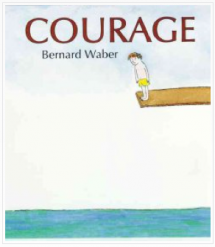 Courage
Courage
by Bernard Waber (Houghton Mifflin Harcourt, 2002)
Publisher Summary What is courage? Certainly it takes courage for a firefighter to rescue someone trapped in a burning building, but there are many other kinds of courage too. Everyday kinds that normal, ordinary people exhibit all the time, like “being the first to make up after an argument,” or “going to bed without a nightlight.” Bernard Waber explores the many varied kinds of courage and celebrates the moments, big and small, that bring out the hero in each of us.
Make Way for Books This thoughtful collection of courage-facets sparkles like new, even though it was published more than 10 years ago. In a most delightful, instructive way, the illustrations are of equal importance to the descriptive text that underlines them. Picture a roller coaster at its final descent (with a few green faces) and its caption: Courage is going on it again; and, a car full of riders followed by: Courage is a scenic car trip and being stuck in the middle during the best part. These enduring wisdom bytes show an expansive courage that includes self-control, responsibility, humility, confidence, trustworthiness, and more.
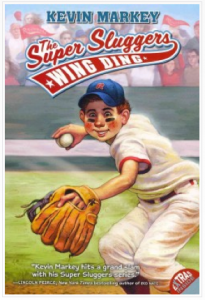 Wing Ding
Wing Ding
by Kevin Markey (Harpercollins, 2012)
Publisher Summary When the windiest weather in Rambletown history blows in a horde of hungry grasshoppers, the only thing the chomping insects devour faster than the grass is the Rounders’ chance to host the midseason all-star game. Unfortunately, their shortstop’s arm has gone haywire. Balls used to disappear into Stump’s glove as if he were a one-man Bermuda Triangle, but since the infestation, he’s jumpier than the grasshoppers. Will the Rounders find a way to rid Stump of the yips—and their home field of insects—before the hated Haymakers hijack the all-star game?
Make Way for Books There is nothing ho-hum about this young-reader sports tale! Nicknames — Flicker Pringle, Walloper, Stump Plumwhiff, Pepper McGraw — personify each player, preparing readers for the delightfully descriptive story that follows:
“For one thing, rings the size of donuts encrusted her fingers..”; “…the deafening roar that greeted us…sounded more like some terrible orchestra made of up of chain saws, dirt bikes, and snowmobiles”; “The base runners were coiled like Olympic Sprinters waiting for the starting gun.”
Markey masterfully blends tall tale-style storytelling and a storyline replete with competitive camaraderie to show the true meaning of All-Star. Additionally, he weaves a somewhat complex science concept into the text and shows its meaning as a critical component of the story’s climax. And (perhaps a teacher’s dream) incorporates student news articles to show what well-crafted summaries look like. End material includes a graphic organizer of the story’s teams, along with wacky facts from baseball history. An undeniable home run!
 More Super Sluggers: Slumpbuster
More Super Sluggers: Slumpbuster
(Harpercollins, 2010)
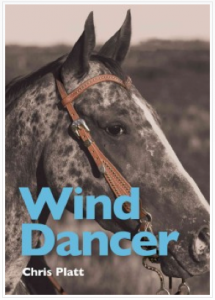 Wind Dancer
Wind Dancer
by Chris Platt (Peachtree, 2014)
Publisher Summary Having lost her beloved pony in a traumatic accident, thirteen-year-old Ali is reluctant to help her parents care for a neglected, malnourished Appaloosa, but working with Wind Dancer is a good distraction from problems surrounding her brother, who recently returned from Afghanistan with a missing leg and PTSD.
Make Way for Books Courage abounds in this tale of putting others first, learning to accept change, and overcome adversity. Honesty, strength of family relationships, and a deep commitment to doing the right thing drive the characters to grow even when it is hard. The complex plot calls for difficult decision making and invites readers to think about what is right and why. A beautiful tale of love, courage, and valuable life lessons. Recommended for ages 9-11, grades 4-6, a little higher than publisher recommendation.
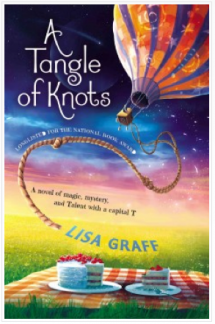 A Tangle of Knots
A Tangle of Knots
by Lisa Graff (paperback – Penguin, 2014)
Publisher Summary Told in multiple viewpoints, A Tangle of Knots is a magnificent puzzle. In a slightly magical world where everyone has a Talent, eleven-year-old Cady is an orphan with a phenomenal Talent for cake baking. But little does she know that fate has set her on a journey from the moment she was born. And her destiny leads her to a mysterious address that houses a lost luggage emporium, an old recipe, a family of children searching for their own Talents, and a Talent Thief who will alter her life forever. However, these encounters hold the key to Cady’s past and how she became an orphan. If she’s lucky, fate may reunite her with her long-lost parent.
Make Way for Books A National Book Award Nominee for 2013, A Tangle of Knots is a beautiful story about Cady, an orphan who has a special talent for seeing people and knowing the perfect cake for them. Told from many different perspectives and with many different characters, it takes a little while for the “knot” to be tied, but with a touch of magic, a little mystery, a lot of warmth and humor, and even some great recipes, the author succeeds in weaving together a delightful story about relationships and how they are woven together.
“If you don’t know the trick, it’s a muddled predicament. But in fact each loop of every knot is carefully placed, one end twisting tight into the other in a way you might not have expected.”
This story will appeal to fans of fantasy, mystery, and stories about family. It may be a little too complex for struggling readers, but would make a perfect read-aloud.
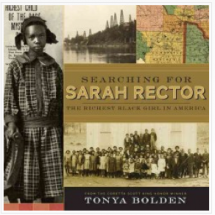 Searching for Sarah Rector: The Richest Black Girl in America
Searching for Sarah Rector: The Richest Black Girl in America
by Tonya Bolden (Abrams, 2014)
Publisher Summary Sarah Rector was once famously hailed as the richest black girl in America. Set against the backdrop of American history, her tale encompasses the creation of Indian Territory, the making of Oklahoma, and the establishment of black towns and oil-rich boomtowns.
Rector acquired her fortune at the age of eleven. This is both her story and that of children just like her: one filled with ups and downs amid bizarre goings-on and crimes perpetrated by greedy and corrupt adults. From a trove of primary documents, including court and census records and interviews with family members, author Tonya Bolden painstakingly pieces together the events of Sarah’s life and the lives of those around her. The book includes a glossary, a bibliography, and an index.
Make Way for Books Reading this book is like sitting under a studied historian who shares facts culled from myriad sources with care. The museum-like quality of the book’s page design and archived photographs lend authenticity to the telling of how a girl, born as a black member of the Muscogee tribe, whose history included forced relocation and the Trail of Tears, became wealthy. Bolden weaves an economics lesson into a colorful tapestry of Oklahoma expansion, land allotments, investments, lending, guardianships, greed, money, and race. The way events are explained and influential people are introduced gives readers time to digest important information. It is evident this was a painstaking work, as confirmed by a comment in the author’s note: “Better to rest on research and reason than on scuttlebutt.” This is as much about the lessons within the story as it is about how the author chose to craft it. A quality work.



